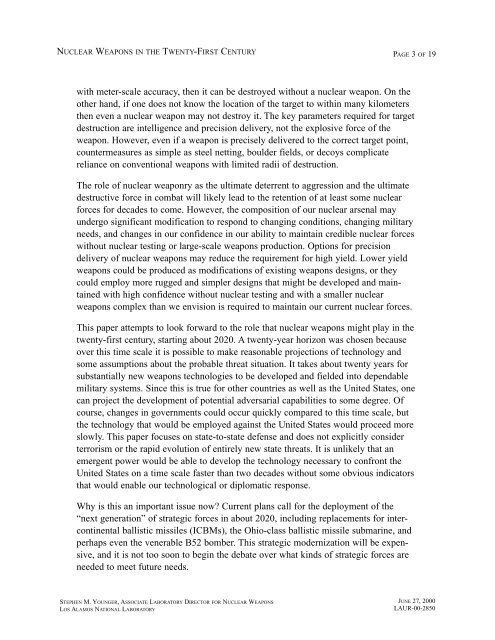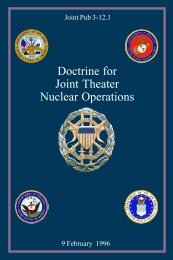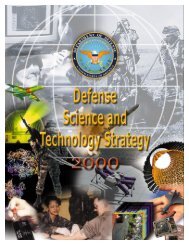Nuclear Weapons in the Twenty-First Century - Sciencemadness.org
Nuclear Weapons in the Twenty-First Century - Sciencemadness.org
Nuclear Weapons in the Twenty-First Century - Sciencemadness.org
Create successful ePaper yourself
Turn your PDF publications into a flip-book with our unique Google optimized e-Paper software.
NUCLEAR WEAPONS IN THE TWENTY-FIRST CENTURY<br />
PAGE 3 OF 19<br />
with meter-scale accuracy, <strong>the</strong>n it can be destroyed without a nuclear weapon. On <strong>the</strong><br />
o<strong>the</strong>r hand, if one does not know <strong>the</strong> location of <strong>the</strong> target to with<strong>in</strong> many kilometers<br />
<strong>the</strong>n even a nuclear weapon may not destroy it. The key parameters required for target<br />
destruction are <strong>in</strong>telligence and precision delivery, not <strong>the</strong> explosive force of <strong>the</strong><br />
weapon. However, even if a weapon is precisely delivered to <strong>the</strong> correct target po<strong>in</strong>t,<br />
countermeasures as simple as steel nett<strong>in</strong>g, boulder fields, or decoys complicate<br />
reliance on conventional weapons with limited radii of destruction.<br />
The role of nuclear weaponry as <strong>the</strong> ultimate deterrent to aggression and <strong>the</strong> ultimate<br />
destructive force <strong>in</strong> combat will likely lead to <strong>the</strong> retention of at least some nuclear<br />
forces for decades to come. However, <strong>the</strong> composition of our nuclear arsenal may<br />
undergo significant modification to respond to chang<strong>in</strong>g conditions, chang<strong>in</strong>g military<br />
needs, and changes <strong>in</strong> our confidence <strong>in</strong> our ability to ma<strong>in</strong>ta<strong>in</strong> credible nuclear forces<br />
without nuclear test<strong>in</strong>g or large-scale weapons production. Options for precision<br />
delivery of nuclear weapons may reduce <strong>the</strong> requirement for high yield. Lower yield<br />
weapons could be produced as modifications of exist<strong>in</strong>g weapons designs, or <strong>the</strong>y<br />
could employ more rugged and simpler designs that might be developed and ma<strong>in</strong>ta<strong>in</strong>ed<br />
with high confidence without nuclear test<strong>in</strong>g and with a smaller nuclear<br />
weapons complex than we envision is required to ma<strong>in</strong>ta<strong>in</strong> our current nuclear forces.<br />
This paper attempts to look forward to <strong>the</strong> role that nuclear weapons might play <strong>in</strong> <strong>the</strong><br />
twenty-first century, start<strong>in</strong>g about 2020. A twenty-year horizon was chosen because<br />
over this time scale it is possible to make reasonable projections of technology and<br />
some assumptions about <strong>the</strong> probable threat situation. It takes about twenty years for<br />
substantially new weapons technologies to be developed and fielded <strong>in</strong>to dependable<br />
military systems. S<strong>in</strong>ce this is true for o<strong>the</strong>r countries as well as <strong>the</strong> United States, one<br />
can project <strong>the</strong> development of potential adversarial capabilities to some degree. Of<br />
course, changes <strong>in</strong> governments could occur quickly compared to this time scale, but<br />
<strong>the</strong> technology that would be employed aga<strong>in</strong>st <strong>the</strong> United States would proceed more<br />
slowly. This paper focuses on state-to-state defense and does not explicitly consider<br />
terrorism or <strong>the</strong> rapid evolution of entirely new state threats. It is unlikely that an<br />
emergent power would be able to develop <strong>the</strong> technology necessary to confront <strong>the</strong><br />
United States on a time scale faster than two decades without some obvious <strong>in</strong>dicators<br />
that would enable our technological or diplomatic response.<br />
Why is this an important issue now Current plans call for <strong>the</strong> deployment of <strong>the</strong><br />
“next generation” of strategic forces <strong>in</strong> about 2020, <strong>in</strong>clud<strong>in</strong>g replacements for <strong>in</strong>tercont<strong>in</strong>ental<br />
ballistic missiles (ICBMs), <strong>the</strong> Ohio-class ballistic missile submar<strong>in</strong>e, and<br />
perhaps even <strong>the</strong> venerable B52 bomber. This strategic modernization will be expensive,<br />
and it is not too soon to beg<strong>in</strong> <strong>the</strong> debate over what k<strong>in</strong>ds of strategic forces are<br />
needed to meet future needs.<br />
STEPHEN M. YOUNGER, ASSOCIATE LABORATORY DIRECTOR FOR NUCLEAR WEAPONS<br />
LOS ALAMOS NATIONAL LABORATORY<br />
JUNE 27, 2000<br />
LAUR-00-2850






